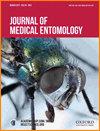Potential zoonotic role of the tick Amblyomma cf. oblongoguttatum (Ixodida: Ixodidae) in the bacterial transmission of Ehrlichia chaffeensis (Rickettsiales: Anaplasmataceae) in a deciduous tropical forest in Mexico
IF 2
3区 农林科学
Q1 ENTOMOLOGY
引用次数: 0
Abstract
Ehrlichia chaffeensis is a bacterium belonging to the Anaplasmataceae family. In Mexico, only 2 species have been recorded in association with tick species and humans. The objective of the present study was to detect the presence of bacteria of the genus Ehrlichia in ticks collected from the Chamela-Cuixmala Biosphere Reserve, Jalisco, Mexico. The collected ticks were identified and analyzed individually by polymerase chain reaction to amplify a fragment of the Anaplasmataceae 16S rRNA gene and the Ehrlichia-specific dsb gene. A total of 204 ticks, corresponding to 5 species of Ixodidae and 1 of Argasidae, were collected from 147 mammals of 6 species and 4 orders; 57 ticks collected from vegetation were also included. Among the total ticks collected, 1.47% (3/204) was positive for Ehrlichia sp. DNA was obtained using the primers EHR 16SD and EHR 16SR for 16S rRNA and DSB-330 and DSB-728 for dsb. The positive samples corresponded to a larva (Amblyomma sp.) associated with Didelphis virginiana and 2 nymphs (Amblyomma cf. oblongoguttatum) infesting Nasua narica. None of the ticks collected from the vegetation tested positive for Ehrlichia sp. DNA on the basis of the 16S rRNA and dsb genes. The sequences from the larvae of Amblyomma sp. and the nymphs of A. cf. oblongoguttatum were similar to those of E. chaffeensis. The phylogenetic analysis inferred with maximum likelihood corroborated the identity as E. chaffeensis. Although the role of these tick species as vectors of E. chaffeensis is still undetermined, the presence of infected ticks in the area indicates a potential zoonotic risk.蜱虫 Amblyomma cf. oblongoguttatum (Ixodida: Ixodidae) 在墨西哥落叶热带森林中传播 Ehrlichia chaffeensis(立克次体:Anaplasmataceae)细菌的潜在人畜共患病作用
Ehrlichia chaffeensis 是一种属于 Anaplasmataceae 科的细菌。在墨西哥,只有 2 个物种被记录与蜱类和人类有关。本研究的目的是检测从墨西哥哈利斯科州 Chamela-Cuixmala 生物圈保护区采集的蜱虫中是否存在埃利希氏菌属细菌。研究人员对采集到的蜱虫进行了鉴定,并通过聚合酶链式反应分别扩增了无形体科 16S rRNA 基因片段和埃利希氏菌特异性dsb 基因片段。从 6 种 4 目 147 种哺乳动物身上共采集到 204 只蜱虫,分别对应 5 种 Ixodidae 和 1 种 Argasidae;还包括从植被中采集到的 57 只蜱虫。在收集到的所有蜱虫中,1.47%(3/204)对埃利希氏菌(Ehrlichia sp.阳性样本分别是与 Didelphis virginiana 相关的一只幼虫(Amblyomma sp.)和侵扰 Nasua narica 的两只若虫(Amblyomma cf. oblongoguttatum)。根据 16S rRNA 和 dsb 基因检测,从植被中采集的蜱虫均未检出埃里希氏菌 DNA 阳性。Amblyomma sp.幼虫和 A. cf. oblongoguttatum 若虫的序列与 E. chaffeensis 相似。用最大似然法推断的系统发生分析证实了与 E. chaffeensis 的同一性。虽然这些蜱虫物种作为E. chaffeensis的传播媒介的作用仍未确定,但该地区受感染蜱虫的存在表明存在潜在的人畜共患病风险。
本文章由计算机程序翻译,如有差异,请以英文原文为准。
求助全文
约1分钟内获得全文
求助全文
来源期刊
CiteScore
4.60
自引率
14.30%
发文量
207
审稿时长
3-8 weeks
期刊介绍:
Journal of Medical Entomology is published bimonthly in January, March, May, July, September, and November. The journal publishes reports on all phases of medical entomology and medical acarology, including the systematics and biology of insects, acarines, and other arthropods of public health and veterinary significance. In addition to full-length research articles, the journal publishes Reviews, interpretive articles in a Forum section, Short Communications, and Letters to the Editor.

 求助内容:
求助内容: 应助结果提醒方式:
应助结果提醒方式:


